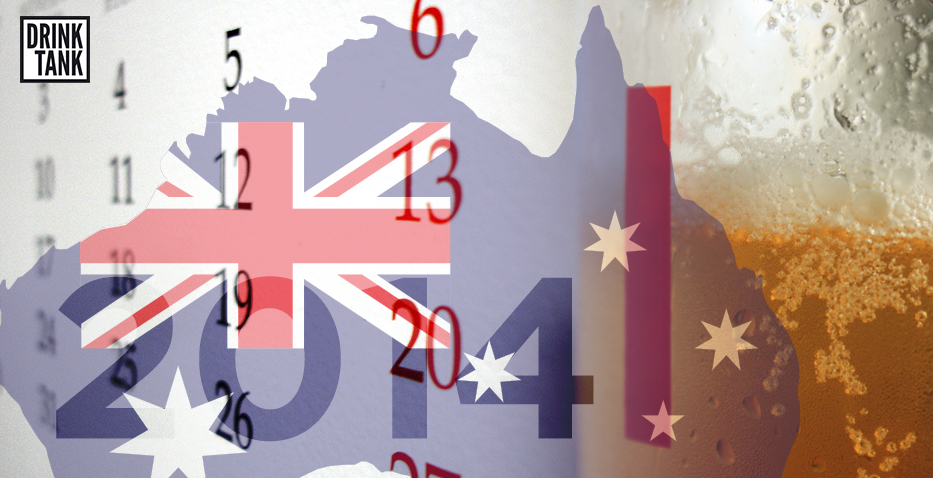As we enter the New Year, Drink Tank spoke to a number of stakeholders working in the alcohol and other drugs sector in Australia. We asked these public health experts to reflect on the past year in alcohol policy and to offer their insights and predictions for what lies ahead in 2015.

- Dr John Crozier, Chair of the National Trauma Committee,
Royal Australasian College of Surgeons - Professor Sandra Jones, Centre for Health and Social Research (CHaSR),
Mary MacKillop Institute for Health Research, Australian Catholic University - Professor Kypros Kypri,
School of Medicine and Public Health, University of Newcastle - Vicki Russell, Chief Executive Officer,
National Organisation for Fetal Alcohol Spectrum Disorders - Michael Thorn, Chief Executive,
Foundation for Alcohol Research and Education - Brian Vandenberg, Executive Officer,
National Alliance for Action on Alcohol - Dr Dennis Young, Executive Director,
Healthy Options Australia
2014 was a year of extremes for alcohol policy in Australia. While some jurisdictions strengthened and improved on their alcohol harm prevention policies, others were simultaneously taking disappointing steps backwards.
“In 2014 we were served a murky cocktail of alcohol policy changes that may well leave us with a nasty hangover,” says Brian Vandenberg.
Perhaps the most noteworthy, and well received, change in the country’s policy landscape in 2014 was the introduction of alcohol harm minimisation measures the NSW Government.
Last summer the then Premier Barry O’Farrell announced an Alcohol and drug fuelled violence initiatives package, which included 3am last drinks and 1.30am lockouts in Sydney’s entertainment districts, as well as a state-wide 10pm closing time for bottle shops.
Effective lobbying by the NSW ACT Alliance for Action on Alcohol Policy (NAAPA), and other public health stakeholders, played an important role in securing these measures and the leadership shown has been widely praised.
“The strong response by the NSW Government to community and media pressure to tackle alcohol-fuelled street violence was a welcome move. The package of measures represented the biggest winding back of trading hours in more than hundred years,” says Michael Thorn.
Despite the concerns of a vocal minority, health and safety were at the forefront of this decision. As Brian Vandenberg notes: “The NSW Government held its nerve in the face of industry lobbying and implemented several liquor control reforms to improve public safety in inner Sydney.”
Professor Kypros Kypri applauded NSW on its approach, saying “O’Farrell’s decision to limit alcohol sales to no later than 3am in the Sydney CBD was in line with what the evidence suggests is likely to reduce the assault rate but unexpected.”
As predicted, one year on it is already apparent that the measures have successfully reduced violence and decreased fear.
“Local residents report significant improvements in the amenity since the introduction of these reasonable measures,” says Dr John Crozier. “It’s also resulted in a dramatic reduction in alcohol related admissions and presentations at the nearest trauma centre, St Vincent’s Hospital.”
Ahead of a formal evaluation, Professor Sandra Jones believes that these measures have already achieved two very important aims: “The NSW initiatives brought about some much needed restrictions (albeit limited) in the availability of alcohol.
“Secondly, the measures got the public and policymakers talking about the need to address the availability of alcohol and sent an important message that the community wants, needs, and can bring about policy change.”
In other Australian jurisdictions, Victoria also made positive progress over the past twelve months.
Brian Vandenberg recalls how “the Victorian Government delighted many local alcohol policy advocates with its decision to legislate for the collection of wholesale liquor sales data.”
Queensland has also experienced significant change during 2014 with long awaited recognition by the Newman Government that there is a need to address alcohol related violence with the introduction of their Safe Night Out Strategy.
Dr Dennis Young says that despite the current discussion on this strategy and its overall effectiveness, the commitment by the government to resource this area is a good first step.
“My main concern for the State is that there is no alcohol strategy or action plan for Queensland.”
Despite the improvements seen at the State level, the Australian Federal Government had a ‘Fizzer’ of a year, scoring very poorly for its inaction and inadequate alcohol harm prevention policies.
“The Federal Government made some curious decisions in 2014, such as placing a two year moratorium on the consideration of the introduction of warning labels on alcohol products sold in this country,” says Dr Young.
Unfortunately the Federal Government’s new Fetal Alcohol Spectrum Disorders (FASD) National Action Plan also has its limitations. FASD advocate Vicki Russell believes the 2014 plan falls short:
“There was no consultation process and the shortfalls are not so much in what has been included, and funded, but in what has been excluded or replaced. For instance, the revised plan has cut any link to support services for those who are living with FASD,” says Ms Russell.
Brian Vandenberg was also concerned by Australia’s culture of inaction, with the Federal Government even going as far as to undo past successes.
“A number of key national bodies which had been contributing to alcohol policy were forced to permanently close their doors during 2014, at the hand of the Federal Government, including the Alcohol and Other Drugs Council of Australia (ADCA) and the Australian National Preventive Health Agency (ANPHA),” he says. “And yet another year passed with a new national alcohol strategy still nowhere in sight.”
Michael Thorn agrees that the absence of a national alcohol plan, the previous version expired in 2011, reflects very poorly on all Australian governments – particularly the Commonwealth:
“There can be no coherent or concerted effort to reduce the annual alcohol toll of more than 5,500 deaths and 150,000 hospitalisations due to alcohol consumption unless all governments accept their critical responsibility to provide leadership to reduce this too high a toll,” said Mr Thorn.








Add comment